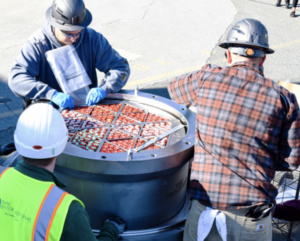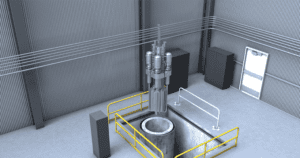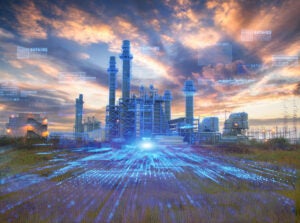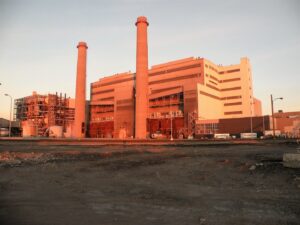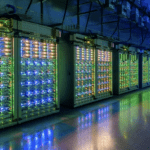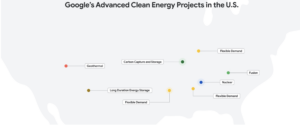
Google has signed a first-of-its-kind corporate offtake agreement to purchase power from a new 400-MW natural gas–fired cogeneration plant outfitted with carbon capture and storage (CCS) in Decatur, Illinois.
In an Oct. 23 blog post, Michael Terrell, head of Google’s Advanced Energy division, unveiled the corporate agreement that will allow the hyperscaler to purchase power from Broadwing Energy Center, a project on which Low Carbon Infrastructure (LCI)—a portfolio company of I Squared Capital—plans to begin construction next year. Broadwing is slated to begin producing power and 1.5 million pounds of steam an hour by the end of 2029. LCI anticipates its carbon capture component will be operational by early 2030.
The project, currently in the permitting phase, is being developed on an existing Archer Daniels Midland (ADM) site in Decatur, adjacent to ADM’s longtime CO₂ sequestration operation. ADM operates one of the nation’s longest-running carbon storage sites in Decatur, where more than 4 million metric tons of CO₂ from its corn-processing operations have been injected about 1.5 miles underground into the Mt. Simon sandstone under an Environmental Protection Agency (EPA) Class VI well permit. Developed with the Department of Energy and the Illinois State Geological Survey, ADM’s system will likely serve as the technical foundation for Broadwing’s planned sequestration network.
The power will be distributed to Google “via the grid and behind the meter to ADM, while the steam is supplied to ADM to their industrial processes,” the facility website notes. If completed, Broadwing would mark one of the first commercial-scale natural gas plants in the U.S. to pair combined heat-and-power generation with carbon capture and dedicated geologic storage. The project also signals how corporate clean-energy buyers are expanding beyond renewable PPAs to back firm, low-carbon capacity—an emerging pillar of reliability as AI and data-center loads surge.
“By agreeing to buy most of the power [Broadwing] generates, Google is helping get this new, baseload power source built and connected to the regional grid that supports our data centers,” Terrell said in his blog post. He also noted the company views the collaboration as a way to “accelerate the path for CCS technology to become more accessible and affordable globally.”
LCI and I Squared have also characterized the project as “a blueprint for delivering reliable, dispatchable, low-carbon power at commercial scale.” Broadwing “demonstrates that carbon capture can be commercially viable today,” said Jonathan Wiens, LCI’s CEO. “Working alongside I Squared and Google, we’re proving that low-carbon power can be both affordable and reliable, while driving job creation and community investment.”
How Broadwing’s Cogeneration System Works
The Broadwing Energy Center is designed to operate as a gas-fired combined heat-and-power (CHP) facility (also known as cogeneration) to produce continuous electricity and process steam, and when operational, is designed to capture and permanently store more than 90% of its CO₂ emissions.
The project will employ a single Mitsubishi Power M501JAC gas turbine, LCI noted. “The captured CO₂ will be compressed and injected into ADM’s EPA Class VI-approved wells, stored permanently more than a mile underground.” The company noted that engineering, procurement, and construction (EPC) services are being led by Kiewit Power Constructors. Project financing is “expected to reach final investment decision in Q2 2026 and commercial operations targeted for 2030,” it said.
LCI documents suggest the project will employ a post-combustion amine absorption system to capture “some percentage” of CO2 from the power plant’s flue gas. Exhaust from the gas turbine will first pass through a heat recovery steam generator (HRSG), which captures waste heat to produce steam used both in ADM’s industrial operations and in the capture process.
The cooled flue gas then moves through a quencher before entering a large absorber column, where it comes into contact with an amine-water solution. The amine “chemically reacts with the CO₂ in the flue gas, bonding with the CO₂ to form a stable compound,” it notes. The resulting CO₂-rich solution is transferred to a regenerator, which uses steam heat to release the absorbed gas. The separated CO₂ is subsequently compressed into liquid form by a series of compressors and permanently stored underground nearby in ADM’s EPA Class VI sequestration wells within the Mt. Simon sandstone formation.
Google’s Newest Pioneering Corporate Agreement
According to Terrell, the project has already achieved substantial progress. “We look forward to helping Broadwing achieve commercial operation by early 2030,” he wrote. “LCI has already engaged a broad range of community stakeholders in the development of the project and will continue to do so throughout its lifecycle. Broadwing is designed to meet rigorous safety and environmental standards and will bring significant benefits to the local community, including creating an estimated 750 full-time jobs over the next four years and supporting dozens of permanent jobs once the plant is running,” he wrote.
For Google, the central driver is access to dependable, low-carbon capacity that can scale with the company’s surging data-center demand and support its commitment to round-the-clock carbon-free electricity across its global portfolio. “Our goal is to help bring promising new CCS solutions to the market while learning and innovating quickly—the same approach we’ve taken with other energy technologies,” Terrell wrote. “Our collaboration with LCI will help fast-track critical technical and operational improvements, from continuing to raise CO2 capture rates to improving system performance and economics.”
The hyperscaler is notably pursuing a deliberate corporate strategy to commercialize next-generation clean firm power through first-of-a-kind procurement structures. Since publishing its 2023 report, “The Corporate Role in Accelerating Advanced Clean Electricity Technologies,” the company has systematically underwritten emerging technologies critical to its 24/7 carbon-free energy (CFE) goal for 2030. Each deal has appeared to pioneer a novel contracting mechanism—utility tariffs, master plant development agreements, or utility-led research frameworks—which are designed to de-risk early-stage deployments as well as create replicable commercial pathways for technologies still climbing the cost curve.
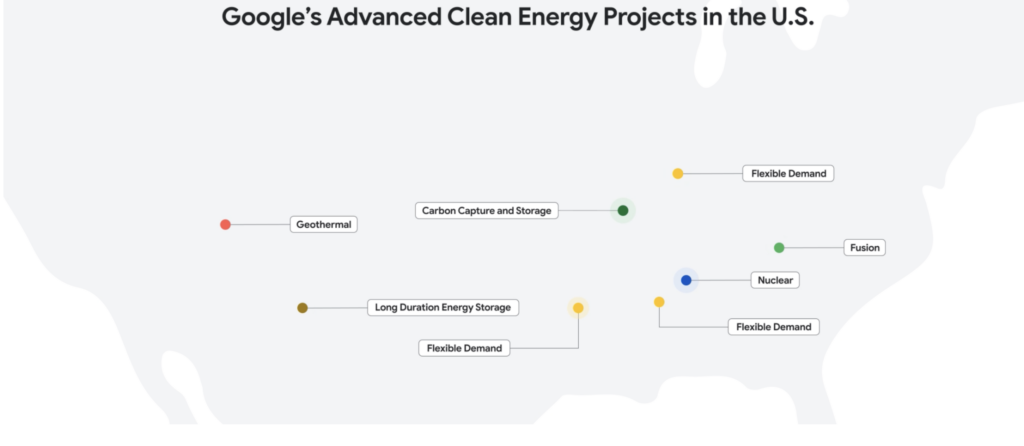
In 2021, Google signed the world’s first corporate geothermal agreement with Fervo Energy to deliver enhanced geothermal power to Nevada data centers and scaling from 3.5 MW to 115 MW through a pioneering Clean Transition Tariff model with NV Energy. In October 2024, the company announced the first U.S. corporate nuclear deal, committing to purchase 500 MW from Kairos Power’s fleet of small modular reactors by 2035. In August 2025, TVA joined the effort with Google, and Kairos, inking the first U.S. utility PPA for a Gen-IV reactor—Hermes 2, a 50-MWe molten-salt unit slated to begin delivering 24/7 carbon-free power to Google’s Tennessee and Alabama data centers in 2030.
In June 2025, Google made its first commercial commitment to fusion energy, signing a 200-MW power purchase agreement with Commonwealth Fusion Systems (CFS) for power from the company’s inaugural ARC fusion power plant in Chesterfield County, Virginia, where operations target the early 2030s. Google, an investor in CFS since 2021, increased its stake in the company and secured options to purchase power from future ARC plants. Google has also supported TAE Technologies, a California-based fusion developer, since 2015, collaborating on machine learning applications to optimize plasma performance and participating in TAE’s 2025 funding round that raised more than $150 million. And in July 2025, Google signed a Hydro Framework Agreement (HFA) with Brookfield Asset Management to procure up to 3,000 MW of carbon-free hydroelectric capacity across the U.S.—marking world’s largest corporate clean power deal for hydropower. The first contracts, totaling 670 MW from Brookfield’s Holtwood and Safe Harbor facilities in Pennsylvania, will supply Google’s operations in PJM.
And in August 2024, Google and Indiana Michigan Power (I&M) filed a landmark contract with Indiana regulators that introduced a dual-purpose arrangement—a Clean Capacity Agreement—that will allow Google to transfer accredited clean capacity from its existing power purchase agreements into I&M’s PJM resource adequacy portfolio, paired with a custom demand response program that enables Google to flex its Fort Wayne data center operations during grid stress periods.
In tandem, Google has also launched collaborative procurement efforts. In March 2024, it launched a partnership with Microsoft and Nucor to aggregate demand for advanced clean electricity technologies such as next-generation geothermal, advanced nuclear, and clean hydrogen. Separately, in September 2025, it initiated a first-of-its-kind long-duration energy storage (LDES) research partnership with Arizona public power utility Salt River Project (SRP) to accelerate non-lithium storage technologies. Google is slated to fund a portion of the costs for LDES pilot projects developed for SRP’s grid, and it will also evaluate data on the pilot projects’ operational performance and provide input on the research and testing plans.
On Thursday, Terrell noted Google is also seeking to address emissions and boost energy efficiency. “Harnessing AI’s immense potential responsibly will require a wide range of solutions. Alongside building our portfolio of advanced clean energy technologies, we are helping people manage emissions in key sectors—like transportation and energy—in transformational ways. In 2024 alone, just five of our AI-powered products helped our users collectively reduce an estimated 26 million metric tons of CO2 equivalent, roughly equivalent to the emissions from the annual energy use of over 3.5 million U.S. homes,” he wrote.
At Broadwing, that commitment to verifiable emissions reductions extends to the accounting layer. “Transparency will also be critical to ensure the environmental integrity of our projects,” Terrell noted. “That’s why the project will incorporate a newly-released standard for CCS-specific Energy Attribute Certificates (EACs), developed by industry experts to ensure CCS projects can be accurately quantified in emissions reporting.”
The CCS EAC standard, published in October 2025 by a consortium of energy registries and carbon accounting experts, is notably the first standardized approach for issuing, tracking, and retiring EACs reflecting CCS-equipped electricity’s environmental profile. Unlike renewable energy certificates (RECs), CCS EACs are minted with an emissions rate in pounds of CO₂ equivalent per megawatt-hour—reflecting actual hourly performance, capture efficiency, and sequestration energy requirements. The standard mandates independent third-party verification across the full lifecycle (generation, capture, transport, storage) and requires self-insurance mechanisms such as private insurance or leakage reserves to protect holders against post-injection seepage. When retired, certificate holders claim emissions reductions in their Scope 2 greenhouse gas inventory under the GHG Protocol. For Google, which reports emissions reductions to stakeholders and investors, the CCS EAC framework provides a credible, auditable mechanism to translate Broadwing’s capture performance into verifiable corporate climate claims—a critical step as corporate buyers increasingly demand precise accountability for emissions reductions embedded in power purchase agreements.
“Many parties at the frontier of electric sector decarbonization have identified the need for and value in creating a standard for issuing EACs for generation with CCS,” write experts at consulting firm NorthBridge Group, which published the standard and guidance earlier this month. “A standardized EAC will promote market confidence, reduce the risk of non-uniform market instruments, and encourage CCS adoption.”
Carbon Capture’s Next Frontier: Data Centers
While global carbon capture deployment has expanded sharply over the past decade, progress for power generation CCS remains nascent compared to other industrial sectors. According to the Global CCS Institute’s Oct. 9–released Global Status of CCS 2025 report, as of July 2025 there were 77 commercial CCS facilities in operation worldwide featuring a combined capture capacity of 64 million tonnes per annum (Mtpa)—a 54% increase from 2024 levels.

The tally of power generation CCS projects globally under development, under construction, or are operational amounts to 88 projects, the report shows. Many power CCS projects are in China. On Sept. 25, notably, China Huaneng placed into operation the 1.5-Mtpa Huaneng Longdong Energy Base CCUS project at the 2 × 1,000-MW Zhengning coal-fired power plant in Gansu Province. That project is now the world’s largest carbon-capture facility integrated with a coal unit. Fully developed with domestic technology, the project uses Huaneng’s proprietary HNC-7 solvent system to capture more than 90% of flue-gas CO₂ for geological storage and utilization, setting a benchmark for scalable, cost-effective decarbonization of coal power.
According to the Global Status of CCS 2025 report, CCS could be key in meeting surging U.S. data center demand—driven by artificial intelligence, cloud computing, and hyperscale expansion. Between 2025 and 2030, about 55 GW of new data center capacity is projected to come online, and roughly 30% is expected to incorporate on-site generation to bypass grid interconnection delays and ensure firm 24/7 power, it projects. To meet this explosive load, natural gas combined cycle (NGCC) plants with CCS are emerging as one of the most practical near-term solutions, offering rapid deployment, geographic flexibility, and alignment with existing CO₂ pipeline and storage infrastructure (see map), it suggests. “On a simple average cost per MWh and a capacity-weighted average cost, NGCC with CCS is the second lowest cost option—lower cost than nuclear, biomass, and even unabated NGCC when tax credits are included. Although geothermal is lower cost, the locations of the data centres could be constrained by the location of geothermal resources, or would have to rely on heavily constrained power grids to bring that power to the data centres,” it says.
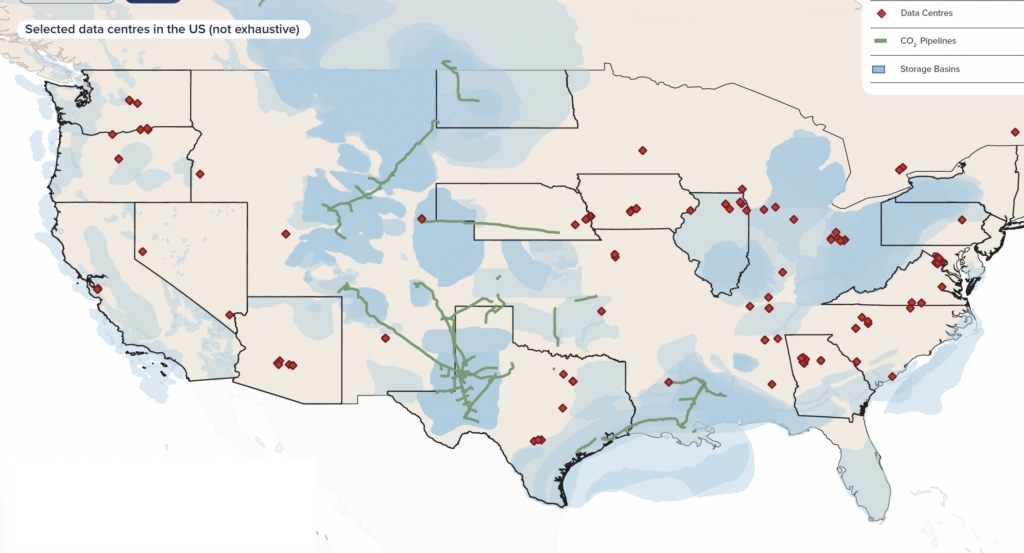
However, recent momentum for CCS has faced policy headwinds. Earlier this month, the U.S. Department of Energy (DOE) announced the cancellation of more than $7.5 billion in DOE projects, which included 55 carbon management initiatives. The reversals stand in stark contrast to continued bipartisan support for the 45Q tax credit, which Congress enhanced in 2025 (as part of the One Big Beautiful Bill) to provide parity for CCS projects utilizing or storing CO₂, noted Jessie Stolark, the executive director of Carbon Capture Coalition, a nonpartisan collaboration. Stolark has noted that policy uncertainty in key jurisdictions has introduced new risks at a critical time, when private capital was beginning to move into the CCS space, and that it could undermine investment signals necessary to scale power-based CCS nationwide.
On Thursday, Stolark lauded Google and LCI’s efforts at Broadwing in Illinois. “The Coalition has been steadfast on the complementary role that carbon capture and storage must play in the power sector. NG + CCS’ value-add is only rising in our current energy system, where affordable, firm, clean dispatchable power is essential to driving our increasingly digital economy, while ensuring we reduce air pollutants and CO2 emissions from new and existing power generation,” she said. “According to Carbon Direct, NG + CCS has the potential to meet nearly two-thirds of the current projected power demand from data centers based on its potential as a timely, reliable, and low-carbon source of power. Increasingly, due to concerns about affordability and timing, companies are entering into power purchase agreements with power producers for new, dispatchable, clean generation that does not increase ratepayers’ bills.”
The project will hold a specific historical relevance when operational, she noted. “This first NG + CCS project linked to a data center not only demonstrates the value of the technology for powering the digital economy, but also the importance of building out supportive transport and storage infrastructure for captured CO2. Since ADM began operation of the U.S.’s first Class VI well more than a decade ago, the company has safely and permanently stored more than 3.5 million metric tons of CO2 under a rigorous regulatory program overseen by the U.S. EPA.”
Experts from the carbon management and tracking firm Carbon Direct also suggested the Google deal points to laudable progress for natural gas power with integrated carbon capture. In a March 2025 analysis, the firm’s experts noted data centers—which prioritize speed, cost, and carbon performance—are fueling a resurgence of interest in capture-ready gas power generation, given their short construction timeframes (as little as 18 to 24 months in favorable locations). “However, past experience shows that capture-ready plants rarely deliver,” they wrote. “The ambition and commitment of the developers were contingent on policy and market signals that were either too small or never materialized. While the base plant may have made economic sense in terms of energy value for investment, it does not appear anyone was willing to pay the climate premium for CCS.”
Google’s Broadwing agreement “is the first evidence of real and large-scale demand for CCS from a company with a proven commitment to its climate goals,” the Carbon Direct experts said in a blog post on Thursday. The deal, they noted, sets a precedent for buyers “to pay a green premium for natural gas power with CCS” and to incorporate the resulting, substantially reduced—but still non-zero—emissions into their Scope 2 inventories using a new EAC developed by the NorthBridge Group. “Most importantly,” the experts wrote, “this project will demystify CCS as a greenhouse gas control technology and help move the industry away from ‘capture-ready’ projects toward ‘capture-committed’ clean, firm generation.”
—Sonal Patel is a POWER senior editor (@sonalcpatel, @POWERmagazine).
Correction (Oct. 24, 2025): An earlier version of this article incorrectly stated that the CCS Energy Attribute Certificate (EAC) standard includes transmission losses in its emissions-rate calculation. In fact, as clarified by The NorthBridge Group, transmission losses are not included in the CCS EAC emissions rate—consistent with established Scope 2 accounting conventions and the treatment of renewable energy certificates (RECs). The text has been updated accordingly. Updated (Oct. 24, 2025): Adds commentary from Carbon Direct.


